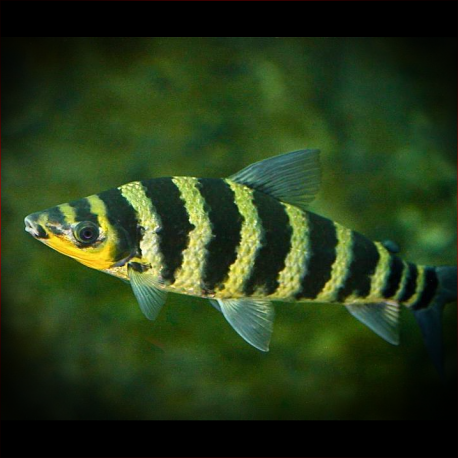More info
Datasheet
| Minimum Tank Size | 750 litres / 198.13 US gallons |
| Maximum Size | 27.0cm / 10.63inches |
| Temperature | 20°C / 68.00°F - 28°C / 82.40°F |
| Hardness | 1.01dgH / 18ppm - 15.02dgH / 268ppm |
| pH | 5.0-7.5 |
General Description
The Banded Leporinus, scientifically known as Leporinus Fasciatus, is a species classified under the order Characiformes. This fish is commonly found in public aquarium displays due to its striking appearance, featuring broad and slightly inclined dark body bars that increase in number as the fish matures, with young specimens having fewer bars that multiply over time. The species can exhibit territorial behavior, especially if kept in small numbers, making it essential to house them in groups of six or more in larger tanks to reduce aggression towards conspecifics.
Aquarium Setup
For optimal care, a tank with a minimum capacity of 750 liters is advised for the Banded Leporinus. When setting up the aquarium, it is crucial to prioritize water quality by maintaining hardness levels between 18-268ppm, a pH range of 5.0-7.5, and a temperature of 20-28°C. Decor elements such as sandy substrate, driftwood branches, twisted roots, and leaf litter can provide a natural environment for the fish. Additionally, ensuring sufficient space and proper oxygenation is crucial, and a secure cover is recommended due to the species' jumping tendencies.
Behaviour
In its natural habitat, the Banded Leporinus tends to swim in large shoals, but in aquariums, they can display aggressiveness towards conspecifics if kept in small numbers. To mitigate conflicts, maintaining the fish in groups of six or more is recommended for larger tanks. When housed with tankmates, peaceful medium to large fishes like certain characids, loricariids, doradids, or reophilic species are suitable companions. However, smaller tankmates are at risk of being preyed upon by the Banded Leporinus.
Feeding and Diet
Banded Leporinus are omnivorous by nature, feeding on algae, invertebrates, and organic detritus in their natural habitat. In captivity, they are not picky eaters and will accept a variety of foods. However, it is best to avoid high-protein diets. Wild individuals have been found with stomach contents containing fruits, seeds, aufwuchs, and occasionally smaller fish, showcasing their varied diet.
Reproduction & Dimorphism
Information on the reproduction of the Banded Leporinus is currently unrecorded. Regarding sexual dimorphism, mature females of the species tend to grow slightly larger and have rounder bellies compared to males. The distinct dark body bars on the fish multiply with age, with juveniles having fewer bars that increase as they mature. These bars offer a unique and visually striking appearance to the fish.
Habitat and Distribution
Banded Leporinus are habitat generalists, commonly found in main river channels, smaller tributaries, oxbows, and floodplain lakes. They are known to undergo annual migrations, with a preference for flooded forest areas during the wet season. This species is widely distributed throughout the Amazon and Orinoco river systems, including major tributaries spanning countries such as Brazil, Bolivia, Peru, and Venezuela. Variations in morphology and color patterns can be observed in different populations based on their specific locality.

